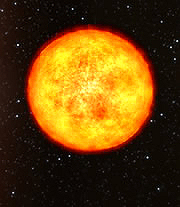Astronomy:HE 1523-0901
| Observation data Equinox J2000.0]] (ICRS) | |
|---|---|
| Constellation | Libra |
| Right ascension | 15h 26m 01.070s[1] |
| Declination | −9° 11′ 38.89″[1] |
| Apparent magnitude (V) | 11.129[2] |
| Characteristics | |
| Evolutionary stage | red giant branch[1] |
| Spectral type | CEMP[3] |
| B−V color index | +1.057[2] |
| Astrometry | |
| Proper motion (μ) | RA: −22.685[1] mas/yr Dec.: −28.204[1] mas/yr |
| Parallax (π) | 0.3278 ± 0.0140[1] mas |
| Distance | 9,900 ± 400 ly (3,100 ± 100 pc) |
| Details | |
| Mass | 0.80[4] M☉ |
| Radius | 27[1] R☉ |
| Luminosity | 730[1] L☉ |
| Surface gravity (log g) | 1.29[4] cgs |
| Temperature | 4,742[4] K |
| Metallicity [Fe/H] | −2.65[4] dex |
| Age | 13.2[5] Gyr |
| Database references | |
| SIMBAD | data |
HE 1523-0901 is the designation given to a red giant star in the Milky Way galaxy approximately 9,900 light years from Earth. It is thought to be a second generation, Population II, or metal-poor, star ([Fe/H] = −2.95). The star was found in the sample of bright metal-poor halo stars from the Hamburg/ESO Survey by Anna Frebel and collaborators. The group's research was published in the May 10, 2007 issue of The Astrophysical Journal.[5]
Age
The star's age, as measured by ESO's Very Large Telescope, is 13.2 billion years. This makes it among the oldest stars[6] and nearly as old as the estimated age of the universe itself (13.8 billion years as measured by Planck). The measurement uncertainty in the age estimate is 0.7 to 2.7 billion years, depending upon the assumptions made to estimate the uncertainty, although the uncertainty in the relative age of this and other stars using the same method is smaller.[5] HE 1523-0901 is the first star whose age was determined using the decay of the radioactive elements uranium and thorium in tandem with measurements of several neutron capture elements.[7] It is believed to have formed directly from the remnants of the first-generation stars that reached the end of their longevity and exploded as supernovae early in the history of known matter.
Designation
The designation "HE 1523-0901" indicates that the star is part of the Hamburg/ESO Survey catalog. A list of astronomical catalogues can be used to find which catalog a star or other object is from based on its prefix. Most objects are listed in several catalogs and will often be known by several different designations.
Observation
HE 1523-0901 is approximately 0.8 solar masses, but the star has expanded until it is some 27 times as large, and has a total luminosity of 730 times that of the Sun. It can be viewed particularly well from the southern hemisphere with the use of a small telescope. It can also be observed from central European latitudes.
See also
References
- ↑ 1.0 1.1 1.2 1.3 1.4 1.5 1.6 1.7 Vallenari, A. et al. (2022). "Gaia Data Release 3. Summary of the content and survey properties". Astronomy & Astrophysics. doi:10.1051/0004-6361/202243940 Gaia DR3 record for this source at VizieR.
- ↑ 2.0 2.1 Beers, Timothy C.; Flynn, Chris; Rossi, Silvia; Sommer-Larsen, Jesper; Wilhelm, Ronald; Marsteller, Brian; Lee, Young Sun; De Lee, Nathan et al. (2007). "Broadband UBVRCIC Photometry of Horizontal-Branch and Metal-poor Candidates from the HK and Hamburg/ESO Surveys. I.". The Astrophysical Journal Supplement Series 168 (1): 128. doi:10.1086/509324. Bibcode: 2007ApJS..168..128B.
- ↑ Placco, Vinicius M.; Beers, Timothy C.; Santucci, Rafael M.; Chanamé, Julio; Sepúlveda, María Paz; Coronado, Johanna; Points, Sean D.; Kaleida, Catherine C. et al. (2018). "Spectroscopic Validation of Low-metallicity Stars from RAVE". The Astronomical Journal 155 (6): 256. doi:10.3847/1538-3881/aac20c. Bibcode: 2018AJ....155..256P.
- ↑ 4.0 4.1 4.2 4.3 Reggiani, Henrique; Ji, Alexander P.; Schlaufman, Kevin C.; Frebel, Anna; Necib, Lina; Nelson, Tyler; Hawkins, Keith; Galarza, Jhon Yana (2022). "The Chemical Composition of Extreme-velocity Stars". The Astronomical Journal 163 (6): 252. doi:10.3847/1538-3881/ac62d9. Bibcode: 2022AJ....163..252R.
- ↑ 5.0 5.1 5.2 Frebel, A. (2007). "Discovery of HE 1523–0901, a Strongly r-Process-enhanced Metal-poor Star with Detected Uranium". The Astrophysical Journal 660 (2): L117. doi:10.1086/518122. Bibcode: 2007ApJ...660L.117F.
- ↑ "Nearby Star Is A Galactic Fossil". Science Daily. May 11, 2007. https://www.sciencedaily.com/releases/2007/05/070510151902.htm.
- ↑ "A galactic fossil: Star is found to be 13.2 billion years old". PhysOrg. May 10, 2007. http://physorg.com/news98033554.html.
External links
- "Astronomers discover HE 1523-0901 star: Almost as old as universe". iTWire. http://www.itwire.com.au/content/view/12098/1066/.
- "Ancient star nearly as old as the universe". NBC News. 11 May 2007. http://www.nbcnews.com/id/18612697.
Coordinates: ![]() 15h 26m 01.2s, −09° 11′ 38″
15h 26m 01.2s, −09° 11′ 38″
 |


